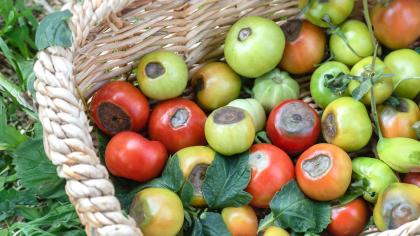We love our tomatoes! All those sizes, colors, and varieties. More Americans grow tomatoes than any other vegetable—or fruit—depending on your personal definition.
The enthusiasm quickly vanishes, however, when we wait for that first tomato to ripen only to discover the bottom is black and rotten. Frustrating! Adding insult to injury, we never saw this black spot because the top and sides looked perfectly delicious.
The culprit is blossom-end rot (BER)—a plant disorder which is the result of lack of water, lack of calcium and cultivation practices. The problem starts at the base of the little yellow flower where it attaches to the young tomato. It becomes noticeable when the tomato is about halfway matured. The spot enlarges as the fruit matures and dries into a leathery looking, black flattened bottom on the tomato.
The good news is, unlike tomato blight, the problem will not spread among plants or from tomato-to-tomato on the same plant. And the better news is, you can easily correct blossom-end rot with these steps.
- Water tomatoes in the spring when they are growing fast. This is especially important for tomatoes grown in containers, where roots can dry out quickly and send the plant into stress. Tomatoes need one inch of water EVERY week during the springtime growing season, 2 inches per week once plants start to fruit. During hot weather, water container tomatoes every morning.
- Tomatoes need calcium. Test the garden soil with a soil test kit. The pH should read between 6.5 - 7.0. Most soils are somewhat acidic and require lime to bring the pH into range. Applying Natural Alternative® Pelletized Garden Lime will provide the calcium tomato plants crave. Additionally, use an organic fertilizer such as Natural Alternative® Organic 5-5-5 All-Purpose Plant Food which has the added benefit of Protilizer® and is full of beneficial microbes. Follow application directions for feeding frequency. Overfeeding, especially at the beginning of the season, can cause plants to grow too quickly and increase blossom-end rot.
- Avoid digging and hoe-weeding too close to the plant base to prevent damaging the root system. Damaged roots could lead to water stress and hinder the uptake of calcium. Weeding by hand is recommended.
- Spreading mulch at the base of the plant with natural mulch helps keep moisture near the root system.
- If you see an unhealthy tomato, remove it from the vine to give the plant more energy for the remaining healthy vegetables.
Blossom-end rot is not exclusive to tomatoes. Peppers, squash and eggplant are also susceptible. Peppers will have black rotten holes on the side and at the bottom. Squash and eggplant shrivel and fall off the vine. Use the same methods for these vegetables as you would for tomatoes.
If you have any questions about blossom-end rot, give us a call or follow us on social media for ongoing helpful tips.



